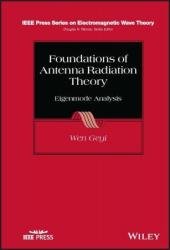 Название: Foundations of Antenna Radiation Theory: Eigenmode Analysis
Название: Foundations of Antenna Radiation Theory: Eigenmode AnalysisАвтор: Wen Geyi
Издательство: Wiley-IEEE Press
Год: 2023
Страниц: 450
Язык: английский
Формат: pdf (true), epub
Размер: 34.7 MB
Foundations of Antenna Radiation Theory Understand the theory and function of wireless antennas with this comprehensive guide.
As wireless technology continues to develop, understanding of antenna properties and performance will only become more critical. Since antennas can be understood as junctions of waveguides, eigenmode analysis—the foundation of waveguide theory, concerned with the unexcited states of systems and their natural resonant characteristics—promises to be a crucial frontier in the study of antenna theory.
Foundations of Antenna Radiation Theory incorporates the modal analysis, generic antenna properties and design methods discovered or developed in the last few decades, not being reflected in most antenna books, into a comprehensive introduction to the theory of antennas. This book puts readers into conversation with the latest research and situates students and researchers at the cutting edge of an important field of wireless technology.
Wireless technologies have revolutionized many different fields in industry as well as in our daily lives. As a vital device in wireless systems, antennas play an important role in boosting overall system performance. The demand on various types of antennas for different wireless applications is growing rapidly, which raises many challenges for antenna designers. For example, wireless terminals have become smaller, and antennas must be squeezed into an even smaller space. At the same time, multiple antenna systems and antennas covering multiple frequency bands are being deployed to wireless terminals to meet the increasing demand for new services and to improve the communication quality. To overcome these challenges, antenna designers need a better understanding of antenna theory.
Antenna theory usually contains three different but related subjects: generic properties of antenna, antenna analysis, and antenna synthesis. The generic properties of antenna are meant to be valid for all antennas, and they are the fundamentals of antenna design. For historical or technical reasons, many of the generic properties of antenna discovered in the last few decades have not yet been reflected in most antenna books. To include these new results in a book, one has to introduce a number of concepts that are barely touched in many antenna books, such as the stored field energy around antenna, the radiation quality factor, and the spherical vector wave functions. Antenna analysis examines the radiation properties of antenna with a specified current distribution, of which the radiated field is conventionally expressed as an integration. Such a process is, however, not always the most efficient since the integration must be carried out for each observation point in order to find the field distribution outside the source region. The antenna synthesis, also called pattern synthesis, is the opposite process of analysis, in which the current distribution or type of antenna, including the geometry and feeding mechanism, is determined in an optimal way so that a prescribed field distribution in the far‐ or near‐field region can be achieved. Since a continuous current distribution is not easy to realize in practice, it must be discretized and then realized by an antenna array. For this reason, various antenna synthesis methods are primarily developed for antenna array. The conventional array synthesis methods are dependent on the array factor, which is no longer effective when the array elements are not identical, the surrounding environment is too complicated, or the inter‐element spacing becomes very small. New array synthesis methods based on eigenmode analysis have been developed in recent years and can overcome the existing problems associated with the array factor, but have not yet been incorporated into textbooks therefore limiting accessibility to students and researchers.
The main theme of this book is eigenmode analysis and its applications in antenna theory and design. The free space can be considered as a spherical waveguide. An antenna may therefore be viewed as a waveguide junction that connects the feeding line and the spherical waveguide, transforming the guided modes into spherical modes in transmitting mode or converting the spherical modes into guided modes in receiving mode. For this reason, it is possible to build a theory for antennas that parallels the theory for waveguides. The eigenmode analysis is the foundation of waveguide theory, and its importance in physics and engineering cannot be overstressed. An eigenmode is a possible state of a system when it is free of excitation, and the corresponding eigenvalue often represents an important quantity of the system, for example the total energy of the system (such as in quantum mechanics) or the natural oscillation frequency (such as in a metal cavity resonator). An arbitrary state of the system can be expressed as a linear combination of the eigenmodes. If only one or a few eigenmodes dominate in the linear combination, this will significantly simplify the analysis of the problem. In the eigenmode expansion of a field, the expansion coefficients are expressed as the integrals over the source region and the integrations are only performed once. After the expansion coefficients are determined, the evaluation of the field distribution outside the source region only involves the sum of series, which decreases the computational burden and simplifies the numerical treatment most of the time as compared to the conventional integral representation.
The book also includes:
Detailed discussions of the solution methods for Maxwell equations and wave equations to provide a theoretical foundation for electromagnetic analysis of antennas
Recent developments for antenna radiation in closed and open space, modal analysis and field expansions, dyadic Green’s functions, time-domain theory, state-of-the-art antenna array synthesis methods, wireless power transmission systems, and more
Innovative material derived from the author’s own research
Foundations of Antenna Radiation Theory is ideal for graduate or advanced undergraduate students studying antenna theory, as well as for reference by researchers, engineers, and industry professionals in the areas of wireless technology.
Скачать Foundations of Antenna Radiation Theory: Eigenmode Analysis